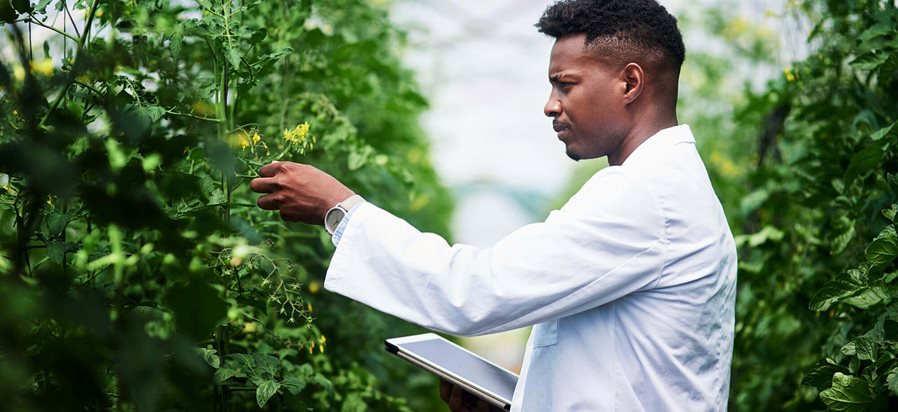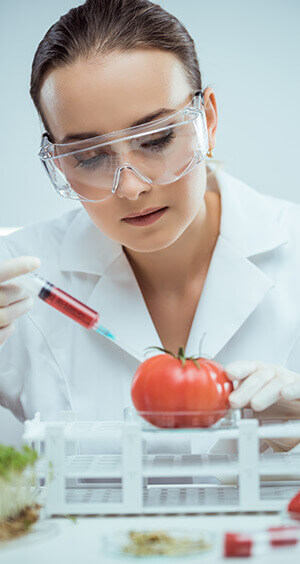
The term farm-to-table whets taste buds and conjures images of fresh, ripe, locally-grown produce suitable for home cooking, restaurants, and takeout. Most of what we consume is derived from grains (wheat, rice, oats, barley, rye, maize), vegetables, fruits, legumes and beans, seeds and nuts, herbs and spices that are produced on farmland. However, few understand the rigorous testing involved with ensuring that farm-grown crops are safe for consumption.
In the U.S., produce is regulated by the USDA (United States Department of Agriculture), EPA (Environmental Protection Agency), and the FDA (Food and Drug Administration). Each of these government agencies, as well as others at the state level plays a critical watchdog role to ensure that our food is fit to distribute and safe to eat. In Europe, FAS (Foreign Agricultural Service) and EFSA (European Food Safety Authority) have similar oversight, while in China, farmers and food distributers are subject to oversight by SAMR (State Administration for Market Regulation). Many other countries have their own equivalent government agency that issues guidelines and implements independent testing for acceptable pesticide levels in food.
 Agriculture is big business throughout the world and while the crops may vary from one country to the next, insects are everywhere. From aphids to zorapteras, bugs hold the power to single-handedly destroy a crop yield. Whether they’re eating their way through leaves, destroying fruit, dropping eggs and feces, or biting farm hands, they are a constant nuisance.
Agriculture is big business throughout the world and while the crops may vary from one country to the next, insects are everywhere. From aphids to zorapteras, bugs hold the power to single-handedly destroy a crop yield. Whether they’re eating their way through leaves, destroying fruit, dropping eggs and feces, or biting farm hands, they are a constant nuisance.
And insects are far from the only pests challenging farms. Rodents, weeds, bacteria, mold and fungus, all present unique challenges on farmlands around the world. For this reason, pesticides are widely used in food production all over the globe.
The good news is that modern pesticides do a great job of limiting damage from all these pests. The bad news is they leave behind residue that can be extremely harmful to humans when ingested. Chemicals like glyphosate (found in RoundUp), Imazalil, acephate, chlorpyrifos, and DCPA (found in Dacthal) have been classified by the EPA as poisonous. Some of these chemicals have been deemed carcinogenic, while others have been shown to adversely impact fertility and brain development.
Who Does the Testing?

It is because of these inherent dangers that government agencies enforce strict guidelines for maximum acceptable trace amounts of pesticides. To avoid hefty fines and legal penalties as well as the threat of losing licensure and business, the farm industry takes compliance very seriously. In many cases, food companies employ the assistance of private, independent expert laboratories like
WESSLING.
 WESSLING
WESSLING began as a small organization in Germany that deployed field experts to test crops and even packaged foods. They’ve been trusted for nearly 40 years by government agencies as well as private companies who rely on their precision laboratory analysis. As global food production and distribution has evolved and grown, so has WESSLING, and today the organization employs 1,600 experts and has presence in more than 25 countries around the world.
We asked Justyna Wójcik, Laboratory Main Specialist at WESSLING in Krakow, Poland, to explain the testing process to us, and it is even more complex and nuanced than we imagined.
How Testing is Conducted
 “We test compliance of products with the requirements established at the EU level, and more precisely with the Regulation (EC) No 396/2005 of the European Parliament and of the Council (Maximum Residue Level – MRL),” Justyna explained to us. “We can also conduct a safety assessment of acute consumer exposure to pesticide residues using the EFSA’s calculation model and Acute Reference Dose (ARfD) values. For the latter approach, we sometimes need to conduct additional testing as the ARfD applies to the edible parts of the products, while the MRL usually applies to the entire product (including inedible parts such as skin). Sometimes clients have their own additional requirements, but it usually corresponds to EU requirements. For example, they set their own maximum level of pesticide residues on 50% of official MRL.”
“We test compliance of products with the requirements established at the EU level, and more precisely with the Regulation (EC) No 396/2005 of the European Parliament and of the Council (Maximum Residue Level – MRL),” Justyna explained to us. “We can also conduct a safety assessment of acute consumer exposure to pesticide residues using the EFSA’s calculation model and Acute Reference Dose (ARfD) values. For the latter approach, we sometimes need to conduct additional testing as the ARfD applies to the edible parts of the products, while the MRL usually applies to the entire product (including inedible parts such as skin). Sometimes clients have their own additional requirements, but it usually corresponds to EU requirements. For example, they set their own maximum level of pesticide residues on 50% of official MRL.”

The prosperity of the food industry depends on reliability. Food manufacturers and suppliers rely on each other, their employees, and the pesticides they use to protect their investment. They further rely on companies like WESSLING to help them comply with legal requirements, ensure food safety standards, and protect their brand. WESSLING, in turn, relies upon their team of credentialed experts and the precision equipment they use to outfit their labs.
“The essential equipment for pesticide residue analysis is a chromatograph with triple quadrupole detector,” Justyna explained to us. A chromatograph is used to separate, analyze, and identify the chemical components of a sample.
“No less important is the equipment used for the preparation of samples: homogenizer, shaker, and centrifuge” Justyna added. “The first step in the analysis is grinding, often under freezing conditions, requiring a robust homogenizer. Then the sample is weighed on a technical balance and extracted with a mechanical shaker. The last step is centrifugation.”
In the course of sample preparation and testing, companies like WESSLING must select instruments that are reliably precise, safe-to-use and easy-to-clean to avoid cross-contamination during sample handling. According to Justyna, “The equipment must meet the test procedure specifications in the first place. The homogenizer must be strong enough to cut samples frozen by liquid nitrogen as a freezing step is required for some single residue methods. The mechanical shaker for extraction step may be horizontal or vertical and must provide very vigorous shaking. The last step is centrifugation for 5 min with 3500 r.p.m. in 50 ml centrifuge tubes. This step may be repeated many times as the samples require clean-up and re-centrifugation in 15 ml centrifuge tubes (or sometimes smaller).”
Choosing a centrifuge that meets required G force and an orbital shaker that produces the proper motion (orbital, rocking, waving, horizontal) with precise speed control and accessories to handle different types of sample vessels is what leads a lot of companies like WESSLING to OHAUS.

For sample preparation, the OHAUS Frontier™ series of centrifuges are an excellent choice. Frontier centrifuges feature fixed angle and swing out rotors that can accommodate 50ml and 15ml conical tubes. Four types of models are available to meet a variety of sample separation needs.
For sample processing, OHAUS Vortex Mixers include a number of suitable options, including the Multi-Tube Vortex Mixer. This powerful, hands-free mixer offers efficient, high-throughput processing and can also accommodate 50mL conical test tubes, which is suitable for running the popular QueChers method for pesticide analysis.
For rapid, high-throughput grinding, the OHAUS HT Lysing Homogenizer makes a great addition to a laboratory. This versatile Homogenizer is one of the most flexible models on the market with a built-in adjustable holder to allow for easy sample processing without accessories.
“This area of research is heavily regulated and we must meet all the requirements to be able to perform tests,” Justyna told us. “We operate in accordance with the requirements of the SANTE guide, which is fundamental in the analysis of pesticide residues. A typical way to ensure quality includes validation of method and then routine quality control, like testing of blank samples, duplicate samples, reference samples, checking of recovery and participation in proficiency testing minimum once a year.”
This is why companies like WESSLING rely on the repeatable results and reliable precision of OHAUS laboratory equipment.